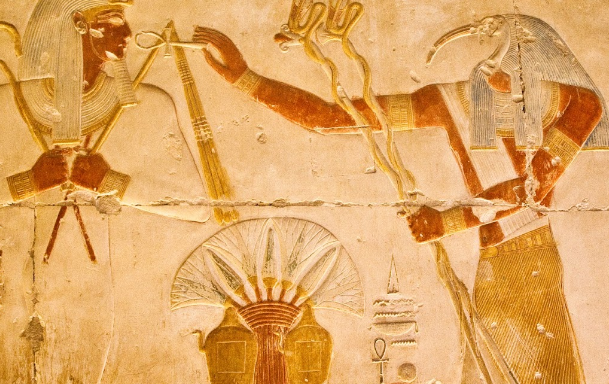
the Rigveda completely confirms the context of the spells
THE HEAD
the area is so complex, that we would not know how to interpret the spells if we cannot first find a working model of it; the above átef-crown, though worn upón the head, representing their head as construct;
the both outer Shu-feathers as axis K and Q; the Uatch-sceptre within the equilibrium of the axis, and the Utcha-eye on top; and that whole construct sitting upon their dualism serpent of both outer Sba stargates;
The ÁTEF crown itsélf is about the place-T, as “the crown / by he / for place-T / of hail”, telling that by place-T-e of eden’s dome, they created their serpent-T-m as the core of the ÁTEF-construct; yet some important links we fail to see at the moment.
In pic 2] the brain, as their construct of ‘the head’, sits next to eden-dome [simply because they are not allowed to take the same place] and we drew the utcha-eye in it’s centre, at the thalamus – which should be saturn’s Self, TCHES, that what we use to call ‘our self’.
The idea is not new – you will find the concept of pituitary and utcha on several sites – but we strongly disagree that this place is one of ‘enlightenment’, since it will lead but directly to their M-realm, above – therefore, we attempt to place their head-construct in proper context, since the general form of human is a fractal of the construct in the Eastern sky. The utcha-eye represents their place-T-m; the curl TÁ of the eye is reaching eden’s dome, the curl being the same as the staff-TÁ, connecting T-e with T-m; and this utcha-eye being at the same place as the lower circle within the átef-crown.
Problem however is the [glyph]connection between the themes – we can see, for example, that the great crown of speech URRT turns into ÃRRTu – the seven stairs up to T-m – but then we get lost, glyph-wise, in connecting them to the KH and TCH clusters. And is actually the reason why we present you this new problem again: we tried to find connections óutside egypt, below, and found concepts like pic 3] the tarot card:
the ‘hand out the cloud’ is Edens Sba-gate, holding up the cup as their head [the chalice NEB, and of gold, NUB]; you see prominent the place-T-m on the cup, the dove which is the utcha-eye on top of the sceptre, and five streams going down to the south-land – interpreted as their now ‘dimensional foreground’ destroying SEK the south-land [either by mutilated eden-light HRU, or as ‘Tuat’, since five streams are depicted]
1] the core of the serpent’s T-m
the above shot, from the tomb of Seti I, shows the flame of seven petals,
and we suspect that this event is within their place-T: the flame itself, as the goddess S-SHAT, Thoth’s feminine Dual, being like “the end of the stream of the stolen Watercourse, which went Up through the seven ãrrit’s to their place T-m“; and though S-SHAT is a but a construct yet incorporating eden-T-e “(that flame) to make the-T by the SH-pool”, we are still working on the glyph relations;
please note how the shape of the flame could resemble ‘a mushroom’;
| 2] leaving Egypt: to Meso-america and India The Mayan deity CHAAC, counterpart of Vedic ape Hanuman – you see the chalice-like vase he holds, with the prominent T upon it; and atop of the chalice a set of flames, in a certain angle: the entire chalice could resemble the shape of a ‘mushroom’, as per above; in context, his counterpart Hanuman destroyed Eden – he “dove into the mouth of a monster, into it’s belly”, in order “to search the soma plant on the hillside of the mountain”, then “lifted up the mountain, altogether”:…it is not difficult to see the opening of the mouth, the split-off Watercourse [as soma] and the creating the KHEMENU mountain, top of thes-domes; |
 |
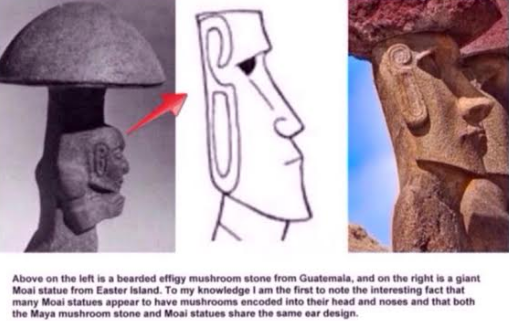
| the source of both pictures (above and right) has found many depictions of the mushrooms in pre-columbian ancient art; obviously, their shamans have seen things, which they translated into an earthly concept which resembled that form the most: therefore it must be a non-discussion to ‘search for the psychedelic effects of certain mushrooms or plants, thinking that was Soma’: the ancients did not really néed to ‘get in a trance state’ – they were already much closer to their ruling spirits; and also the epithets of Soma do not fit to the aspects caused by ‘mushrooms’ [or ayahuasca or any other drug, for that matter]. | 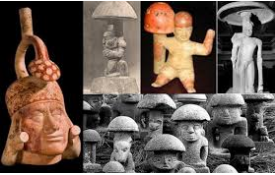 pic credit: mushroomstone com, both |
All religions are off-shoots of the same Fallen ones; and the pictured statues at Easter-island may very well depict a mushroom as nose and eyebrows; since the people have carved something they actually sáw – which was so flabbergasting to them, that they repeated the theme over and over again, to be remembered on earth – and related to the ‘head’.
Several of those statues wear broad-lined ‘hats’, presumably as extension of the mushroom itself; and today, we have a religion in which the males wear the same type hats – confirming that the Pantheon’s religions on this earth are completely intertwined; however, our question is, whether Soma is related to the mushroom-form, depicted in the S-shat-flame above..?
3] India: the gods and Soma
|
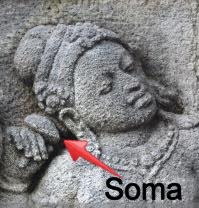 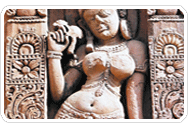 |
- the ‘attaining the light’ (sic), as non-intoxication, is congruent with the non-psychedelic
state: being in contról over senses, and as having active physical strength, etc – it sounds
like the split-off Watercourse:
| A] the deity Rudra: as Watercourse/bull-cherub in Rigveda, the three deities who are the most related with Soma, are Indra [Saturn], Agni [Thoth,see tomb Seti, above] and Rudra; the first two obviously wánting it – as opposed to Rudra:
|
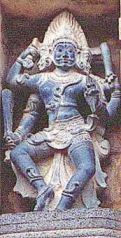 |
- he is often so mixed-up with Shiva [Osiris], that Rudra is either representing Adam physically [which Osiris stole], or representing a ‘construct’, when f.e. in opening of the mouth Osiris is their entire Torus construct, Rudra may represent here the bull-cherub, since both show a bull/cow as attribute,
- the name cognate with -rud, “ruddishness, red”, as typical aspect of Eden [glyph T’ESHER],
- called “the archer”, where the arrow is an attribute of him: in glyphs, the ‘arrow’ is, without exception, likened to “the power of the Word”,
- in RV 2 “fierce like a formidable wild beast”, (*) where the term ‘beast’ should relate to a realm-construct; compare 7 cows in several spells, or the animal-humans (the cherubs) in Ezekiel, see pages: the term ‘beast’ having another connotation as ‘serpent’;
- is said to have “healing remedies”, “the best physician of physicians”, “keeps villages free of illness” and as “possessor of a thousand medicines” (*) – which is particularly interesting since Hanuman the ape sought healing plants from the mountain (eden’s), and these lines indicate characteristics óf the Soma!
- Rudra stating “I am fire and I am soma; fire and soma am I; I bear my seed in my body, [..] and sprinkle all creatures with it”; where the Vedic story tells that Rudra was in the pine-forest as ithyphallic being, and his erect member decorated with white, red and black chalk, when it was cut-off by the peoples of the forest; and when we also add the soma ancient epithet as “the bull bursting with semen” (link*), then he could even represent the bull-cherub at the Watercourse! – with the nature as ‘bull’, representing exact the physical aspects of realm and body, which the M-realm so needed for its sons, whose aspects are depicted as three colours of ‘chalk’, as AB-glyph,
B] related: the VALA stone-serpent: as Eden’s firmament
read: he is the gem-stone-dome of eden [the to-be sea of glass], see Ezekiel pages for context; and as verses in Rig Veda:
Begat the fire between two stones, the spoiler in warriors’ battle, He, O men, is Indra.
He tore away their deftly-built defences. These things did Indra in the Soma’s rapture.
Consumed him as tongues eat what teeth have compassed: he threw the prisons of the red cows open.
The Gods came pressing to thy side, and free from terror aided thee
- note the line ‘fire between the stones’, and compare opening of Mouth pages:
where the chisel is used to separate eden’s double-gem-dome; - the term ‘cave’ as TEPH’ET cave, as region of the gem/stone,
- Saturn, as Indra, ‘freed the 7 rivers’, as the rivers flowing to the South-land
(*pic,diagram on top of page); and compare today’s London ritual of the van
driving-through a crowd near a mosque at the “seven sisters avenue”, - the “bullwarks of the mountain” is ofcourse when (the ruling mountain is) Eden’s,
- the “red cows” is typical eden’s seven area’s below the dome [if not a reference
also to the fouth bull-cherub], and the ‘red’ as eden-aether, blushyness [t’esher], - he ‘spread the firmament’, the latter being the name of the stone in Ezekiel;
and the spreading as PETCH or perhaps PEGA, creating the Torus, - the mentioned Soma being raptured-away by Indra/Saturn leaves no other
interpretation: the stolen nectar by the split-off Watercourse,
C] the deity Vibhishana: Cain, helping Saturn/Indra,
“Vibhishana had a sattvic (pure) mind and a sattvic heart. From his early childhood, he spent all his time meditating on the name of the lord, [and] Eventually, Brahma appeared..” (*)
|
 |
note: about the picture:
Cain stands to the right, and we have immediately our problem here: namely the throne in the centre – is the throne’s roof of 5,6 covering cobra’s the covered mushroom/Seshat-flame, or is it the device pictured as ‘seat’? (see next sections)
D] the deity Kambhakarna: as cube-H
“He(Vibhishana) was younger brother of the Lord of Lanka, Ravana and King of Sleep, Kumbhakarna”,
- the ‘brother’ relating to ‘the same type post-eden body’,
- where Kumbarkana is “cube-H”:
“Despite his monstrous size and great appetite, he was described to be of good character and great warrior in those times, though he killed and ate many monkeys only to show his power. He was considered so pious, intelligent and unchallenged warrior in battle that Indra, the king of gods, was worried and jealous of him and his strength.” (*)
|
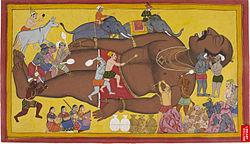
|
- that Indra/Saturn was ‘jealous’, is exact the same description Ezekiel gives: ‘the image of jealousy, in the north Sba-stargate’,
“When the time came for asking a boon (blessing) from Brahma, his tongue was tied by goddess Saraswati who was acting on Indra’s request; because of which, instead of asking Indraasana (seat of Indra), he asked for Nidraasana (bed for sleeping).”
During the war, Ravana went into battle and was humiliated by Rama and his army. He decided he needed the help of his brother Kumbhakarna, who was awakened with great difficulty. He woke up only after one thousand elephants walked over him (Rāmāyaṇa 6.48.47).” (*) - the ‘tongue’ is related to ‘mouth’, as eden’s foundation/stone; and Sarasvati must be ‘knowledge, feminine intuition’ as glyph SAÄ – where Rigveda 10 calls her ‘possessor of knowledge’ – but remember AÁ has the ‘backwards-glyph’, as part of the glyph Orion, ssaáh’;
- the ‘to sleep’ has to be glyph NETCHER, “the dome (eden’s) to sleep by the border-sky of existence”,
- when Adam had fallen (‘humiliated by Rama’), his brother (showing relationship) cube-H woke, finding out the power of the solarplane hoovering above the cube (the 1000 elephants);
…the both ‘larger ears’ may be the both outer Sba-gates:
only now we see that possibility – as ‘ears’, MESTCHER,E] queen Sarama: Cain’s wife
“When Vibhishana attained the position of the King of Lanka, he turned his subjects from the path of evil to the path of Dharma (righteousness). His wife, Queen Sarama also aided him in this effort.”
“Sarama was born on the banks of the Manas lake. Seeing the waters of the lake rise, the infant started crying. Her mother commanded the lake, Saroma vardhata (“Lake, do not rise”), so the child was named Sarama”. and, “Vibishana is attached with the legend of Srirangam Ranganathaswamy temple, considered the abode of Vishnu on earth and the primary temple of Vishnu on earth.” (*)
|
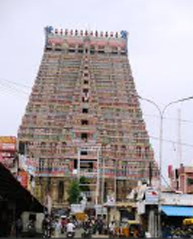 |
- F] the golden fortress Lanka: from Eden eye to Sba gate
“Lanka is the island fortress capital of the legendary demon king Ravana in the epics of the Ramayana and the Mahabharata. The fortress was situated on a plateau between three mountain peaks known as the Trikuta Mountains The ancient city of Lankapura is thought to have been burnt down by Hanuman. After its king, Ravana, was killed by Rama with the help of Ravana’s brother Vibhishana, the latter was crowned king of Lankapura. The site of Lankā is identified with Sri Lanka.” (*)
|
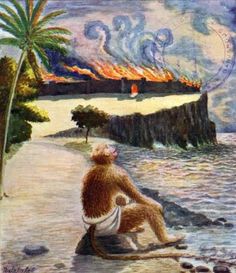 |
continued:
NEXT: vedic epos Ramayana describing the start of invading Eden >>>
(link*) as Magic Mushrooms in Religion and Alchemy, Clark Heinrich


